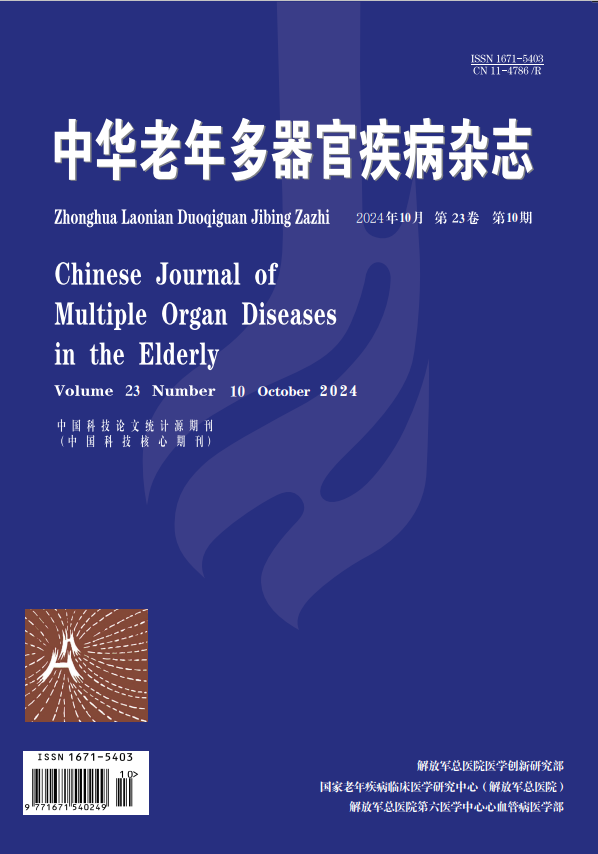Effect of tirofiban on short-term prognosis of elderly patients with acute coronary syndrome undergoing percutaneous coronary intervention
引用次数: 0
Abstract
Objective To evaluate the effect of tirofiban on short-term prognosis of elderly patients with acute coronary syndrome (ACS) who underwent percutaneous coronary intervention(PCI).Methods Totally 325 ACS patients were divided into two groups: Tirofiban group(n = 210) and control group(n= 115).All subjects underwent PCI with drug-eluting stents.Patients in tirofiban group received tirofiban,in addition to aspirin and clopidogrel.Patients in control group received oral administration of aspirin and clopi-dogrel only.The general data,the rate of thrombolysis in myocardial infarction(TIMI) grade 3 flow immediately after PCI,the in-stent thrombosis incidence,mild and severe bleeding rate,platelet decrease rate,mortality,and incidences of myocardial infarction (MI) and target vessel revascularization(TVR) at 30 days after PCI were compared between the two groups.Results The rate of TIMI grade 3 flow immediately after PCI was significantly higher in Tirofiban group than in control group(99.05%vs 94.78%,P0.05).The in-stent thrombosis incidence was lower in Tirofiban group than in control group(0.47%vs 3.47%,P0.01).The mortality and incidences of MI and TVR at 30 days after PCI were lower in Tirofiban group than in control group(0.00%vs 2.61%,0.47%vs 3.47%,and 0.47%vs 1.73%,P0.01).The mild bleeding rate was higher in Tirofiban group than in control group,with no significant difference(7.14%vs 4.35%,P0.05).The rates of severe bleeding and platelets decrease were not significantly different between the two groups(0.00%vs 0.00%,and 0.95%vs 0.87%,P0.05).Conclusion Tirofiban can improve the TIMI grade flow in elderly patients with ACS after PCI.It can also decrease the in-stent thrombosis incidence,mortality,and incidences of MI and TVR at 30 days after PCI,but do not increase the rates of severe bleeding and platelets decrease in these patients.So it can improve the short-term prognosis in elderly patients with ACS undergoing PCI.替罗非班对经皮冠状动脉介入治疗老年急性冠脉综合征患者短期预后的影响
目的探讨替罗非班对老年急性冠脉综合征(ACS)患者行经皮冠状动脉介入治疗(PCI)短期预后的影响。方法325例ACS患者分为替罗非班治疗组(210例)和对照组(115例)。所有受试者均行PCI药物洗脱支架。替罗非班组患者在阿司匹林和氯吡格雷的基础上给予替罗非班治疗。对照组患者仅口服阿司匹林和氯吡狗格雷。比较两组一般资料、PCI术后即刻心肌梗死(TIMI) 3级血流溶栓率、支架内血栓发生率、轻、重度出血率、血小板减少率、死亡率、PCI术后30 d心肌梗死(MI)及靶血管重建术(TVR)发生率。结果替罗非班组PCI术后即刻TIMI 3级血流率显著高于对照组(99.05%vs 94.78%,P0.05)。替罗非班组支架内血栓发生率低于对照组(0.47%vs 3.47%,P0.01)。替罗非班组PCI术后30 d心肌梗死死亡率、心肌梗死发生率、TVR发生率均低于对照组(0.00%vs 2.61%,0.47%vs 3.47%, 0.47%vs 1.73%,P0.01)。替罗非班组轻度出血率高于对照组,差异无统计学意义(7.14%vs 4.35%,P0.05)。两组患者大出血及血小板减少率差异无统计学意义(0.00%vs 0.00%, 0.95%vs 0.87%,P0.05)。结论替罗非班可改善老年ACS患者PCI术后TIMI级血流。它还可以降低支架内血栓发生率、死亡率以及PCI术后30天心肌梗死和TVR的发生率,但不会增加这些患者严重出血和血小板减少的发生率。可以改善老年ACS患者行PCI的短期预后。
本文章由计算机程序翻译,如有差异,请以英文原文为准。
求助全文
约1分钟内获得全文
求助全文
来源期刊
自引率
0.00%
发文量
3039
期刊介绍:
Chinese Journal of Multiple Organ Diseases in the Elderly (monthly) is a medical academic journal under the supervision of PLA General Hospital, sponsored by PLA General Hospital Medical Innovation Research Department, National Clinical Medical Research Center for Geriatric Diseases (PLA General Hospital), and Department of Cardiovascular Medicine of the Sixth Medical Center of PLA General Hospital, and publicly issued at home and abroad. This journal was founded in June 2002 and is a Chinese Science and Technology Paper Statistical Source Journal (China Science and Technology Core Journal), and is included in major domestic retrieval systems and well-known domestic and foreign retrieval systems such as the American Chemical Abstracts.
As the only academic journal in China that reflects multi-organ diseases in the elderly, Chinese Journal of Multiple Organ Diseases in the Elderly mainly exchanges the diagnosis and treatment experience and lessons of cardiovascular diseases in the elderly, especially cardiovascular diseases in the elderly combined with other diseases, diseases of more than two organs in the elderly, and other multiple diseases in the elderly, explores their pathogenesis and effective diagnosis and treatment measures, and focuses on reporting the latest clinical, basic and preventive achievements and experiences in the research of the above diseases in my country with innovative significance; the main readers are medical, scientific research and teaching personnel engaged in geriatric cardiology and (or) geriatric medicine and related diseases.
The main columns include expert comments, special forums, clinical research, basic research, clinical pharmacy, case reports, new technologies and methods, clinical pathology discussions, reviews, academic trends, expert popular science lectures, etc.

 求助内容:
求助内容: 应助结果提醒方式:
应助结果提醒方式:


